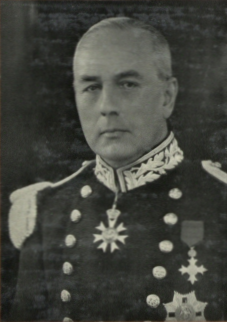Top Qs
Timeline
Chat
Perspective
Shenton Thomas
British colonial administrator (1879–1962) From Wikipedia, the free encyclopedia
Remove ads
Sir Thomas Shenton Whitelegge Thomas GCMG, OBE, KStJ (10 October 1879 – 15 January 1962) was a British colonial administrator, best remembered as the Governor of the Straits Settlements at the time of the Japanese invasion during the Second World War.
Born in England, Thomas spent the majority of his early career in the Colonial Service in Africa, rising to become Governor of Nyasaland and of the Gold Coast. He was appointed to the Straits Settlements in 1934, serving as Governor until 1942, when he became a Japanese prisoner-of-war after the fall of Singapore. He served again as Governor of the Straits Settlements after the war, from 1945 until 1946, when the territory was broken up.[1]
Remove ads
Early life
Thomas Shenton Whitelegge Thomas was born on 10 October 1879, in Southwark, London to The Rev Thomas William Thomas and his wife Charlotte Susanna (née Whitelegge) Thomas.[2][3][4]
He was educated at St. John's School, Leatherhead[5] and Queens' College, Cambridge.[6] Thomas taught at Aysgarth School in Yorkshire prior to entering the Colonial Service.
Africa
In 1909, Thomas was appointed as Assistant District Commissioner, East Africa Protectorate (Nairobi, Kenya).[7][8] In 1919, he was appointed Assistant Chief Secretary, Uganda and in 1920 as Chairman of the Uganda Development Commission.[7][8]
In 1921, he was appointed Principal Assistant Secretary, Nigeria and in 1923, was appointed Deputy Chief Secretary, Nigeria.[7][8] In 1927, he was appointed Colonial Secretary, Gold Coast Colony (Ghana) before he was appointed Governor of Nyasaland in 1929. In 1932 he was appointed Governor and Commander-in-Chief of the Gold Coast Colony (Ghana).[7][8]
Remove ads
Malaya
In 1934, he was appointed Governor and Commander-in-Chief of the Straits Settlements and High Commissioner of the Federated Malay States.[7][8]
Singapore
Thomas was a prisoner-of-war (POW) during the Japanese occupation of Singapore (15 February 1942 – 15 August 1945) having decided to stay in Singapore during the war. He was imprisoned in Cell 24 of Changi Prison along with missionary Ernest Tipson.[1]
After the war, Thomas remained as the 11th British High Commissioner in Malaya (9 November 1934 – 1 April 1946), until the Malayan Union was established and succeeded the British administration in the Straits Settlements (except for Singapore, which was created as a distinct crown colony), Federated Malay States and Unfederated Malay States, where the post of Governor-General of the Malayan Union was created. Shenton Way, a road in Singapore, was named after him.[9]
Remove ads
Personal life
His brother was Hugh Whitelegge Thomas (1887-1960), a colonial commissioner and Cambridge cricketer.[10] He married Lucy Marguerite (Daisy) Montgomery (1884-1978) daughter of James Montgomery[11] on 11 April 1912 at St Jude's Church, Kensington, London.[4]
Thomas died on 15 January 1962, at his home in London. He was 82.[1]
Legacy
Thomas is widely associated in his role as governor with the loss of Singapore and his civilian administration's apparent failures to properly assess the growing Japanese threat and make appropriate defences.[12] Singapore's capture by the Japanese, in conjunction with other events at the time such as the sinking of Prince of Wales and Repulse, severely undermined British prestige and contributed to the eventual end of colonialism in the region.
During the 1950s, Shenton Way, a road in Singapore's central business district, was named after him as recognition of his decision to remain and become a prisoner of war (POW) at Changi Prison when the Japanese occupied Singapore.[9]
Remove ads
Gallery
- St Jude's Church, Kensington, London, where Thomas married in 1912
- Queens' College, Cambridge football team 1900-1901, including Sir Shenton Thomas (second from right, middle row), Charles Tate Regan and Samuel Day.
Honours
 Officer of the Order of the British Empire (OBE) (1919)[13]
Officer of the Order of the British Empire (OBE) (1919)[13] Companion of the Order of St Michael and St George (CMG) (1929)[14]
Companion of the Order of St Michael and St George (CMG) (1929)[14] Knight Commander of the Order of St Michael and St George (KCMG) – Sir (1930)[15]
Knight Commander of the Order of St Michael and St George (KCMG) – Sir (1930)[15] King George V Silver Jubilee Medal (1935)[16]
King George V Silver Jubilee Medal (1935)[16] Knight Grand Cross of the Order of St Michael and St George (GCMG) – Sir (1937)[17]
Knight Grand Cross of the Order of St Michael and St George (GCMG) – Sir (1937)[17] King George VI Coronation Medal (1937)[18]
King George VI Coronation Medal (1937)[18] Knight of Grace of the Order of Saint John (KStJ) (1938)[19]
Knight of Grace of the Order of Saint John (KStJ) (1938)[19]
Remove ads
See also
- Elizabeth Choy – Singaporean educator and resistance worker during World War II
Notes
- The fall of Singapore and subsequently the Japanese occupation.
References
External links
Wikiwand - on
Seamless Wikipedia browsing. On steroids.
Remove ads



